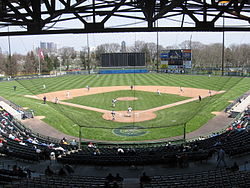Cooper Stadium
This article needs additional citations for verification. (June 2011) |
"The Coop","County Stadium" | |
 | |
 | |
| Former names | Red Bird Stadium (1932-1954) Jets Stadium (1955-1970) Franklin County Stadium (1977-1984) |
|---|---|
| Location | 1155 West Mound Street Columbus, OH 43223 |
| Owner | Franklin County |
| Operator | Franklin County |
| Capacity | 17,500 (1932-1959) 12,000 (1960-1976) 15,000 (1977-2008) |
| Field size | Left Field - 355 ft Center Field - 400 ft Right Field - 330 ft |
| Surface | Natural Grass (1931-1983, and 1998-present) AstroTurf (1984-1997) |
| Construction | |
| Broke ground | 1931 |
| Opened | June 3, 1932[1] |
| Renovated | 1977 |
| Closed | September 1, 2008 |
| Construction cost | $450,000[1] ($10 million in 2024 dollars[2]) |
| Architect | Howard Dwight Smith[3] |
| Tenants | |
| Columbus Red Birds (AA) (1931-1954) Columbus Blue Birds (NNL2) (1933)[4] Columbus Bullies (APFA/AFL) (1938-1941) Columbus Jets (IL) (1955-1970) Columbus Magic (ASL) (1979-1980) Columbus Clippers (IL) (1978-2008) | |
Cooper Stadium was a baseball stadium in Columbus, Ohio and was the home of the minor league Columbus Clippers from 1977 to 2008.
History
Cooper Stadium has had several names over the years, including Red Bird Stadium, Jets Stadium, and Franklin County Stadium, but in 1984 the stadium was renamed in honor of Harold Cooper, the county commissioner who was responsible for keeping baseball in Columbus in the 1950s. The stadium is owned and operated by the Franklin County, Ohio government. It is located in the section of the city known as Franklinton. Built in 1931 by the St. Louis Cardinals, Red Bird Stadium was constructed using the same blueprints used for creating the Red Wing Stadium in Rochester, N.Y. in 1929. The Cardinals owned both teams when the respective stadiums were built. Cooper Stadium was renovated to its present configuration in 1977 to coincide with the return of minor-league baseball to Columbus after a six-year absence. It presently seats 11,000 in a single deck grandstand with an additional 4,000 overflow bleacher seats. Fans would ring cowbells to get Clippers rallies started.
Tenants and events
Over the years, Cooper Stadium has been home to the Columbus Red Birds, a farm team for the St. Louis Cardinals; the Negro league Columbus Blue Birds;[4] the Columbus Jets; and, after the renovation was completed, the Columbus Clippers. From 1939 through 1941, Cooper Stadium (then named Red Bird Stadium) was also home to the Columbus Bullies, two time champions of the third American Football League.
The stadium has also hosted a number of other events, such as roller derbys, music concerts (including Aerosmith, Bob Dylan & Garth Brooks), and hosted evangelist Billy Graham.
Cooper Stadium also hosted the OHSAA Ohio high-school boys baseball State Tournament.
Final baseball game
The Clippers moved from Cooper Stadium after the 2008 season to a new ballpark, Huntington Park, which is located in the Arena District in downtown Columbus. On September 1, 2008, the final game was played as the Toledo Mud Hens defeated the Columbus Clippers in front of 16,770 fans, the third largest crowd in stadium history.

Racetrack conversion
As of May 1, 2008, a proposal to turn the site of Cooper Stadium into an auto racing facility was being considered.[5] This is not a completely new use for the facility, as the parking lot south of the stadium has been used for Sports Car Club of America and autocross racing as well as motorcycle training. On June 27, 2011, the Columbus City Council voted to rezone the site to allow for a racetrack to be built.[6]
Columbus Board of Zoning Adjustment approved 4-0 on December 20, 2011 for a special permit that will clear the way for developer Arshot Investment to build a half-mile racetrack, automotive research and technology center. Arshot plans to spend up to $40 million to develop the 47-acre site.[7]
Rumored plans also include a $22 million overhaul to eventually become the OHSAA stadium for most outdoor events (baseball, football, soccer, lacrosse, etc.). This would then make Cooper Stadium a multi-purpose stadium.[citation needed]
References
- ^ a b Cooper Stadium - Project Ballpark
- ^ 1634–1699: McCusker, J. J. (1997). How Much Is That in Real Money? A Historical Price Index for Use as a Deflator of Money Values in the Economy of the United States: Addenda et Corrigenda (PDF). American Antiquarian Society. 1700–1799: McCusker, J. J. (1992). How Much Is That in Real Money? A Historical Price Index for Use as a Deflator of Money Values in the Economy of the United States (PDF). American Antiquarian Society. 1800–present: Federal Reserve Bank of Minneapolis. "Consumer Price Index (estimate) 1800–". Retrieved February 29, 2024.
- ^ Jagtiani, Aruna (March 11, 1998). "Smith's Architecture Discussed". Northwest Columbus News. Retrieved April 13, 2012.
- ^ a b Lowry, Philip J. (2006). Green Cathedrals: The Ultimate Celebration of Major League and Negro League Ballparks. New York: Walker Publishing Company, Inc. pp. 77–78. ISBN 0-8027-1562-1.
- ^ "Developer Could Turn Cooper Stadium Into Racetrack". 2008-05-01. Retrieved 2011-06-22.
- ^ Lane, Liz (2011-06-27). "Columbus City Council OK's Racetrack". NBCi4 Columbus. Retrieved 2011-06-28.
- ^ Ferenchik, Mark (2011-12-21). "Columbus City Approves Special Permit". Columbus Dispatch. Retrieved 2012-05-08.
